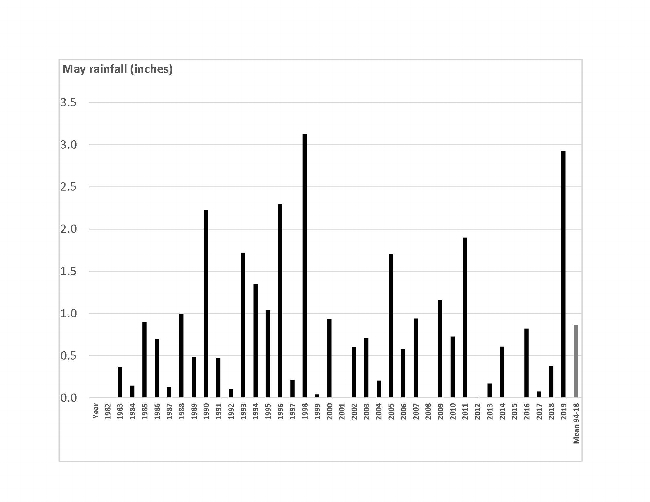During the January UCCE Rice Winter Grower meetings I asked the audience a number of questions related to how they managed rice in 2019 when they planted during or after the mid to late May rains. As you recall, 2019 May rainfall was one of the highest on record with almost 3 inches falling between mid to late May (see Figure below showing average May rainfall from three CIMIS stations (Durham, Colusa and Davis). Thanks to all of you who participated. We had roughly 140 people respond. About 50% of farmers reported planting their last field by May 25; however, almost 40% of respondents said their last rice field was planted after June 1. These June plantings were more common on fields located east of the Sacramento River as most farmers were able to get their fields in earlier on the west side. Over 80% of the respondents said that in fields planted after the rains, yields were down by up to 10 sacks/ac; while 15% said they were the same. Also, about 25% of farmers reported that grain quality was lower in the late planted fields.
The management area that most farmers said was most challenging was land preparation (37%), followed by weed management (23%), stand establishment (13%) and nutrient management (10%). With respect to weeds, 32% said weed control was similar to other years. For farmers reporting that it was more challenging, most reported that grasses (44%) were the most difficult to control, followed by sedges (18%) and broadleaves (6%). About 50% of farmers reported that the efficacy of their herbicides was worse than normal. Both Kassim and Whitney felt that these two results are not surprising. The grass weeds were able to take advantage of the rains and germinate earlier than the rice making them more difficult to control. Furthermore, granular herbicide efficacy may also have been affected by deeper than normal flooding depth (diluting herbicides) at the beginning of the season, if rains came soon after planting.
Many reported land preparation to be very challenging. About one third of farmers reported that in late planted fields they skipped one or more tillage passes; while 12% skipped rolling. About 80% reported applying aqua-ammonia, although 20% of farmers had to apply aqua to wet soil, while 60% applied to dry soil and may have had to do some extra tillage passes to encourage soil drying. That leaves 20% of farmers that used granular fertilizers for their total N requirement. How these fertilizers were applied (before or after planting) was mixed. This is an area that I will be looking at more this year in an effort to develop better strategies to apply granular fertilizer when aqua is not an option.
Finally, and not necessarily related to the wet year, M-206 remained the most popular medium grain variety overall. It was the main variety planted for 48% of respondents and was grown widely in all regions of the Sacramento Valley. M-209 was the second most popular variety and most widely grown on the west side-particularly in Glenn and Colusa counties. The variety M-105 was planted mostly in Butte County where it was the main variety for over 50% of the respondents in that area. Interestingly, M-105 was not planted as much in the southern part of the valley where it yields well and heads relatively early. Talking with some growers, while they like the yields, they feel M-105 may be more prone to lodging than M-206 which delays harvest.
If you missed the rice grower meeting this year, the presentations can be seen at http://rice.ucanr.edu/Presentations/Winter_Grower_Meetings/.
